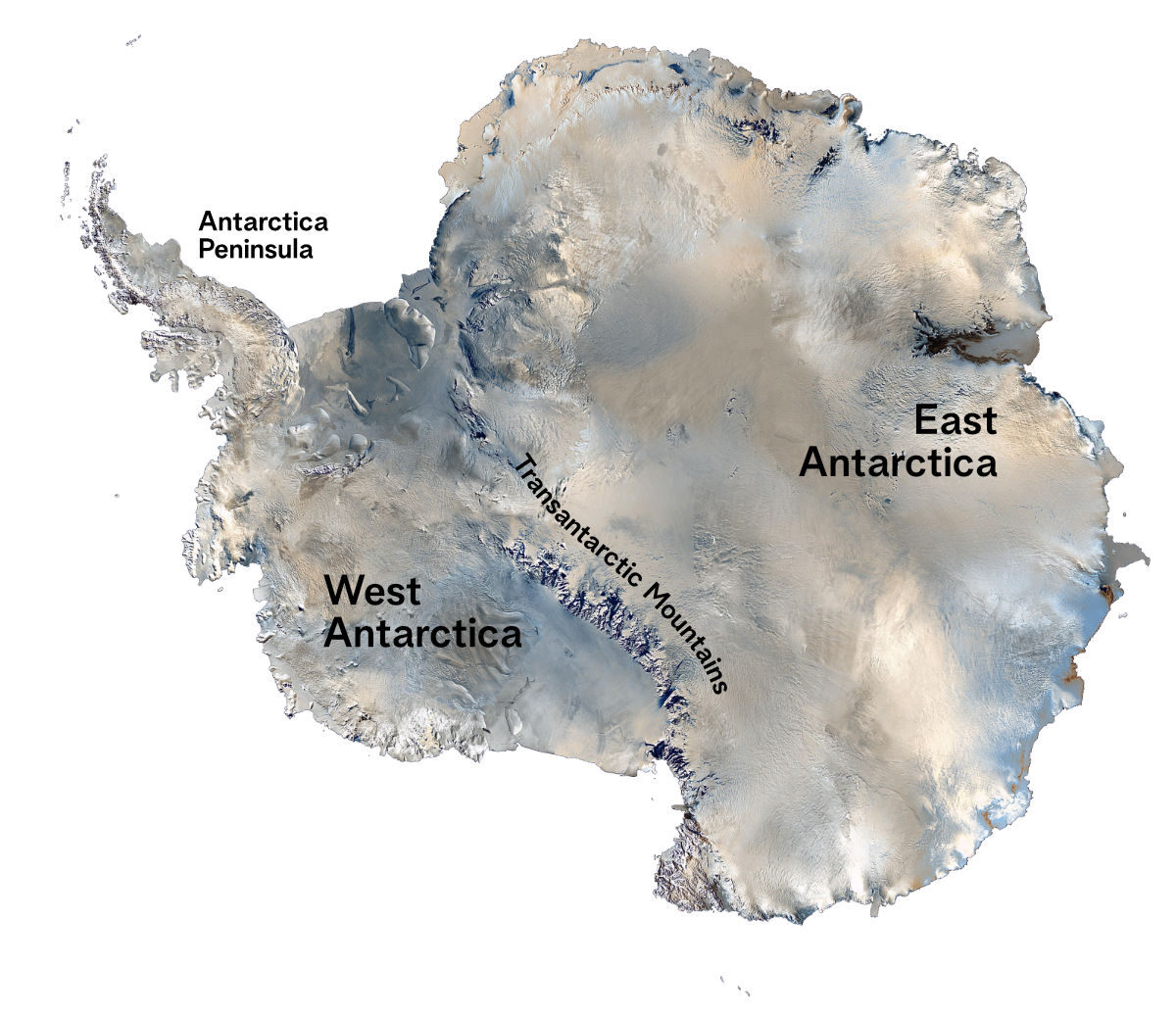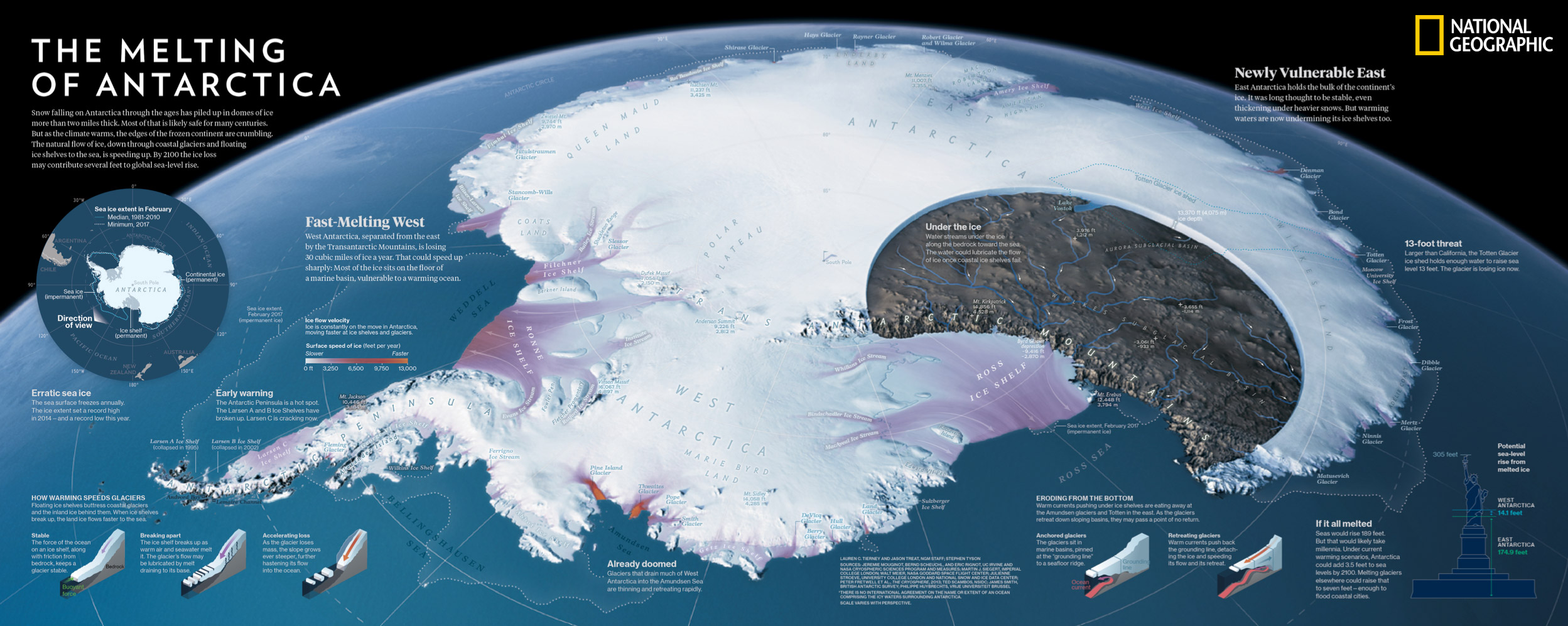Overview
A global crisis is inevitable as Antarctica experiences increasing ice melt due to climate change. In November 2021, Kyrios announced the year-long intervention to urgently bolster Antarctic Ice and avert further sea level rise. However, Kyrios says it is “orders of magnitude more difficult” than past interventions to put out wildfires in Siberia, Amazon and Australia, or reduce torrential rainfall to alleviate floods in China, Japan and Malaysia. This will be Kyrios’ greatest challenge yet. As the fifth largest continent, Antarctica’s ice sheet thickness averages 2.1km with the maximum at 4.6km, dwarfing many mountains and highlands across the world. If all of its ice melts, sea levels will rise by a whopping 60m - that’s 14 storeys high! In this video, we will cover West Antarctica’s fast-diminishing glaciers and what is at stake, latest research by scientists, and how Kyrios is helping to preserve Antarctic ice!
The Antarctica Continent

Antarctica is the Earth’s southernmost continent. Surrounded by the Southern Ocean, it is geographically divided into East and West Antarctica by the Transantarctic Mountains. As a polar desert, there is very little precipitation, which limits the amount of ice that can be replenished. As such, Antarctica is actually losing mass due to increasing ice melt through glaciers and ice streams. Containing 70% of the world’s freshwater frozen as ice, Antarctica holds the largest storage of ice on Earth. Most of Antarctica is covered by its two ice sheets, the East and West Antarctic ice sheet, which covers a combined area of almost 14 million square km and contains 30 million cubic km of ice. The ice sheet in the east is bigger and thicker and rests on bedrock that is mostly above sea level. Whereas the ice sheet in the west is classified as a marine ice sheet because the topography beneath the ice sheet is largely below sea level. Antarctica is also the coldest place on Earth, where the lowest natural temperature ever recorded of -89.2°C at ground level was measured.
Climate Change Melting Antarctic ice
Video: Antarctic ice loss from 2002-2016 (Source: NASA Climate Change)
Despite its remote location, Antarctica is not immune to climate change. In fact, the situation has been rapidly deteriorating in recent years. Since the early 1990s, Antarctica has lost roughly three trillion tons of ice. The South Pole has experienced warming of three times the global average in the last decade. Total ice loss in Antarctica due to climate change has increased from 43 gigaton per year on average from the years 1992 to 2002, to an average of 220 gigaton per year from 2012 to 2017 – a staggering fivefold increase! The Antarctic Peninsula, part of West Antarctica, has also lost a number of ice shelves, many the size of a small country. And recently, scientists have warned that glaciers in West Antarctica have passed the point of no return and are now in an irreversible decline.
Over the 20th and 21st centuries, West Antarctica has been warming faster than other regions in Antarctica. As such, it has seen the most dynamic changes. Although it comprises just 10% of the volume of the entire Antarctic ice sheet, West Antarctica currently contributes the most to sea level rise, primarily from the Pine Island, Thwaites and Smith glaciers. All three glaciers are deteriorating rapidly, losing mass at an increasing rate, and showing signs of glacier disintegration with acceleration in speed, thinning and inland retreat.
Perhaps, the most alarming glacier of all in West Antarctica is the Britain-sized Thwaites Glacier, the widest glacier in the world, spanning 120 kilometres. It is nicknamed the “Doomsday Glacier’’ due to its potential to cause sea level rise of 65 centimetres if all of it melts completely. Unfortunately, the pressing question that scientists are facing is not if the Thwaites Glacier will collapse, but when and how quickly it does so. Scientists have warned on 13 December 2021 that the key ice shelf whose protecting role slows the flow of this glacier seaward, is likely to disintegrate within 3 to 5 years. When that happens, the speed of Thwaites’ ice flow to the sea may accelerate by 3 times or higher. This will ultimately lead to the collapse of the entire West Antarctic ice sheet and raise sea levels by 3 metres.
The cause of ice melt and what Kyrios is doing about it
Figure: The Melting of Antarctica (Source: National Geographic / 2017 Antarctica Special Report)
So what’s causing Antarctic ice to melt? Apart from warmer air temperatures caused by global warming that is melting Antarctica’s surface ice, scientists have also discovered that warm ocean currents are accelerating the melting of West Antarctica’s ice from beneath, where most of the ice sits on bedrock below sea level. Their research coincides with Kyrios’ remote observations of what’s happening in the Antarctic, which is why Kyrios explained that the intervention would require a simultaneous top and bottom approach to stabilise ice across the continent. It is incredibly challenging because Kyrios has to effect changes not only to the weather and atmospheric temperatures, as Kyrios has often done in other climate interventions, but this time, Kyrios must also attempt to reduce ocean temperatures surrounding the Antarctic.
By comparison, Kyrios explains that the intervention to restore ice in the Arctic region which began in August 2021 is simpler because the key to increasing ice volumes was through a top-down approach of generating cold air in the upper atmosphere. One of the ways this was achieved, was by strengthening the stratospheric polar vortex which led to stronger winds and higher snowfall, thereby facilitating the freezing of the Arctic seas where the coldness can then spread from the surface downwards to the depths of the sea. The intervention led to a reversal in the declining year-on-year trend of the Arctic sea ice extent and volume, so much so that in October 2021, many ships transiting along the Northern Sea Route that relied on meteorological forecasts of an ice-free November became stuck in thick frozen ice from the unexpected early freeze. Countries in the northern hemisphere also experienced the early onset of winter and record-breaking snowfall. Data also confirmed a significant increase in overall snow mass across the northern hemisphere following Kyrios’ intervention.
Kyrios remarked that the intervention in the Arctic, which helped to cool the northern hemisphere, was also meant to set the stage for the Antarctic intervention. In order to substantially cool the Antarctic, southbound ocean currents from the northern hemisphere need to be colder as it converges with the Antarctic Circumpolar Current that flows around Antarctica. A cooler Circumpolar Deep Water and a cooler Antarctic Circumpolar Current around Antarctica will help reduce temperatures in the Antarctic region, while also stemming glacier deterioration due to warm deep ocean water of 1-2°C at the grounding zones. Having more ice in the north will also help to cool the Earth’s interior, which Kyrios says is overheated and must be addressed.
A warmer Earth core has dire consequences for the Antarctic region. Corroborating Kyrios’ assessment that heat from Earth’s interior is contributing to Antarctic ice melt, scientists have recently discovered that significant geothermal heat beneath the ice prevents the bottom of glaciers from freezing completely, thus forming a film of water. This then acts as a basal lubricant that causes ice masses to slide more easily over the ground, thereby accelerating the flow of glaciers considerably. Geothermal heat has also enabled the formation of vast hidden networks of under-ice rivers and lakes beneath the Antarctic ice sheet. When Kyrios was exploring the Antarctic remotely, Kyrios also remarked on the existence of these hidden water bodies describing them as “long-kang”, which means drain-like channels.
Kyrios reiterates that forests must not be burned because forest fires will not only affect the local and global weather, but the heat emitted will also spread laterally underground, reaching the seas and warming the waters and the underlying ocean currents if the fires are near the seas. Heat can also travel deep within Earth’s interior, further heating up Earth’s crust and the deep ocean water near the ocean bed, leading to accelerated melting of glaciers and increased seismic and volcanic activity. Kyrios explains that volcanoes act as vents to relieve Earth’s interior of excessive heat. Do you know that West Antarctica has the densest region of volcanoes in the world, with over 100 volcanoes below the Antarctic ice sheet? Volcanic activities in Antarctica arising from the warming of Earth’s interior and the resulting seismic activity may trigger a domino effect of glaciers disintegrating across Antarctica, leading to a sudden rapid sea level rise and tsunamis enveloping coastal cities globally. This could potentially render all current modelling of sea level rise projections to be inaccurate.
Kyrios says that the four seasons today are in chaos, and the climate and weather are severely out of balance. Extreme and severe weather events are becoming more frequent while various disasters have been breaking historical records. These are warning signs that our natural systems are in a state of disequilibrium, and Earth is sending us distress signals. Although communities and organisations in many countries have launched wide-scale campaigns and protests to save the Earth, many country leaders and wealthy business owners trivialised the crisis for the sake of profiteering, choosing instead to continue damaging the Earth’s ecosystem with little regard for the lives of people.
It is everyone’s duty to save the world. We should take concrete actions to change our lifestyle and behaviours. We shouldn’t just indulge in life’s pleasures and let days and months idly go by. Instead, we must find ways to resolve the root causes of our climate crisis and avert the impending climate catastrophes in order to avoid a future filled with endless disasters and the anguish of losing loved ones.
Stay tuned for more updates on how Kyrios is saving Antarctic ice. Share this video with your friends and family to help them understand the ins and outs of how the Earth works; to re-examine the connection between our lives and the ecology of the Earth, as well as the urgency of our global climate crisis.
For more information on Kyrios’ climate crisis interventions, please go here. If you have questions, feel free to ask them here.
